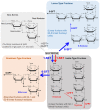Spatiotemporal Dynamics of Oligofructan Metabolism and Suggested Functions in Developing Cereal Grains
- PMID: 26834760
- PMCID: PMC4717867
- DOI: 10.3389/fpls.2015.01245
Spatiotemporal Dynamics of Oligofructan Metabolism and Suggested Functions in Developing Cereal Grains
Abstract
Oligofructans represent one of the most important groups of sucrose-derived water-soluble carbohydrates in the plant kingdom. In cereals, oligofructans accumulate in above ground parts of the plants (stems, leaves, seeds) and their biosynthesis leads to the formation of both types of glycosidic linkages [β(2,1); β(2,6)-fructans] or mixed patterns. In recent studies, tissue- and development- specific distribution patterns of the various oligofructan types in cereal grains have been shown, which are possibly related to the different phases of grain development, such as cellular differentiation of grain tissues and storage product accumulation. Here, we summarize the current knowledge about oligofructan biosynthesis and accumulation kinetics in cereal grains. We focus on the spatiotemporal dynamics and regulation of oligofructan biosynthesis and accumulation in developing barley grains (deduced from a combination of metabolite, transcript and proteome analyses). Finally, putative physiological functions of oligofructans in developing grains are discussed.
Keywords: antioxidant; cereals; grain development; oligofructan; spatial distribution; stress response.
Figures



Similar articles
-
Spatio-temporal dynamics of fructan metabolism in developing barley grains.Plant Cell. 2014 Sep;26(9):3728-44. doi: 10.1105/tpc.114.130211. Epub 2014 Sep 30. Plant Cell. 2014. PMID: 25271242 Free PMC article.
-
Phloem Transport of Fructans in the Crassulacean Acid Metabolism Species Agave deserti.Plant Physiol. 1998 Feb 1;116(2):709-14. doi: 10.1104/pp.116.2.709. Plant Physiol. 1998. PMID: 9490769 Free PMC article.
-
Increasing abscisic acid levels by immunomodulation in barley grains induces precocious maturation without changing grain composition.J Exp Bot. 2016 Apr;67(9):2675-87. doi: 10.1093/jxb/erw102. Epub 2016 Mar 7. J Exp Bot. 2016. PMID: 26951372 Free PMC article.
-
Application of cereals and cereal components in functional foods: a review.Int J Food Microbiol. 2002 Nov 15;79(1-2):131-41. doi: 10.1016/s0168-1605(02)00187-3. Int J Food Microbiol. 2002. PMID: 12382693 Review.
-
Biomarkers of cereal food intake.Genes Nutr. 2019 Oct 12;14:28. doi: 10.1186/s12263-019-0651-9. eCollection 2019. Genes Nutr. 2019. PMID: 31632507 Free PMC article. Review.
Cited by
-
Sweet Immunity: The Effect of Exogenous Fructans on the Susceptibility of Apple (Malus × domestica Borkh.) to Venturia inaequalis.Int J Mol Sci. 2020 Aug 16;21(16):5885. doi: 10.3390/ijms21165885. Int J Mol Sci. 2020. PMID: 32824325 Free PMC article.
-
Overexpression of HvCslF6 in barley grain alters carbohydrate partitioning plus transfer tissue and endosperm development.J Exp Bot. 2020 Jan 1;71(1):138-153. doi: 10.1093/jxb/erz407. J Exp Bot. 2020. PMID: 31536111 Free PMC article.
-
The Immunomodulatory Properties of β-2,6 Fructans: A Comprehensive Review.Nutrients. 2021 Apr 15;13(4):1309. doi: 10.3390/nu13041309. Nutrients. 2021. PMID: 33921025 Free PMC article. Review.
References
-
- Albrecht G., Biemelt S., Baumgartner S. (1997). Accumulation of fructans following oxygen deficiency stress in related plant species with different flooding tolerances. New Phytol. 136 137–144. 10.1111/j.1469-8137.1997.tb04740.x - DOI
-
- Aman P. (1987). The variation in chemical-composition of Swedish oats. Acta Agric. Scand. 37 347–352. 10.1080/00015128709436567 - DOI
-
- Aman P., Hesselman K., Tilly A. C. (1985). The variation in chemical-composition of Swedish barleys. J. Cereal Sci. 3 73–77. 10.1016/S0733-5210(85)80035-7 - DOI
-
- Archbold H. K. (1940). Fructosans in the monocotyledons, A review. New Phytol. 39 185–219. 10.1111/j.1469-8137.1940.tb07132.x - DOI
-
- Arroyo A., Bossi F., Finkelstein R. R., Leon P. (2003). Three genes that affect sugar sensing (abscisic acid insensitive 4, abscisic acid insensitive 5, and constitutive triple response 1) are differentially regulated by glucose in Arabidopsis. Plant Physiol. 133 231–242. 10.1104/pp.103.021089 - DOI - PMC - PubMed
Publication types
LinkOut - more resources
Full Text Sources
Other Literature Sources

